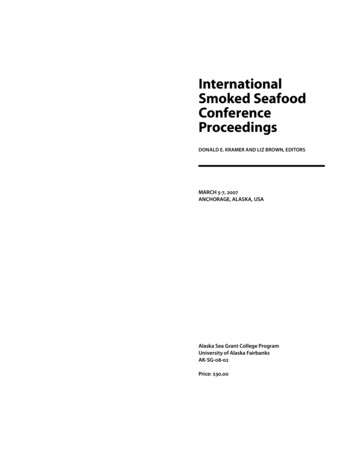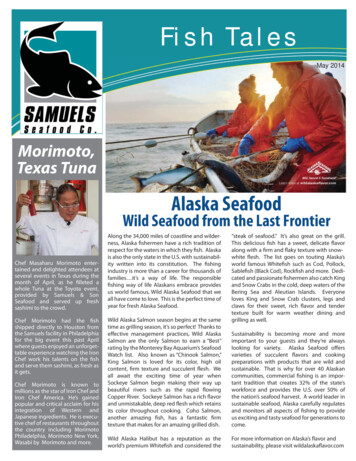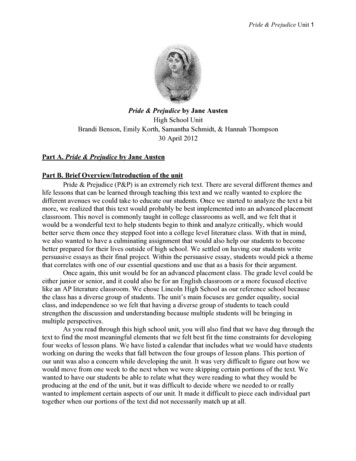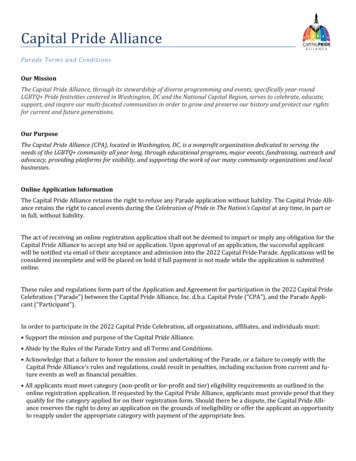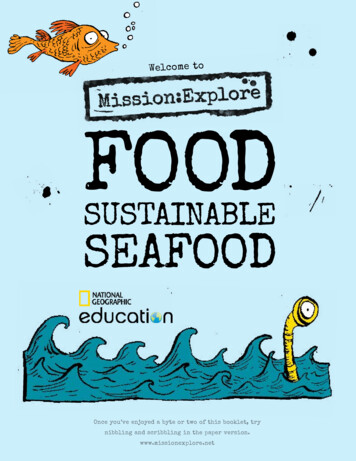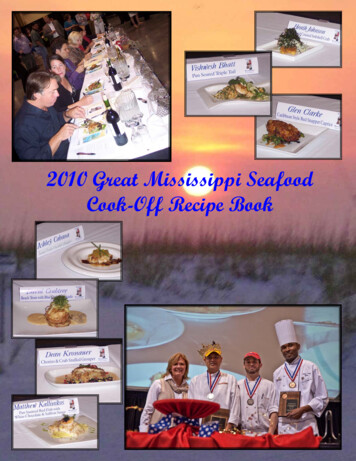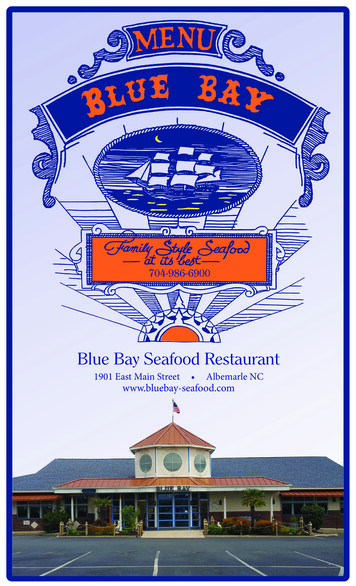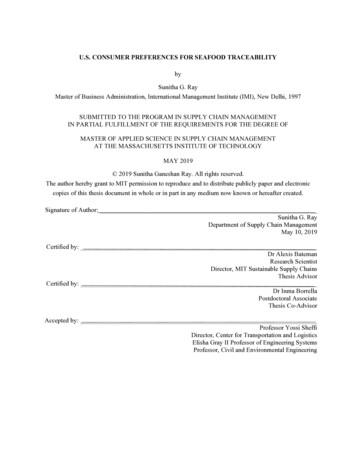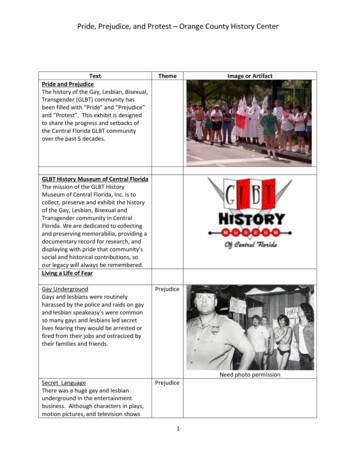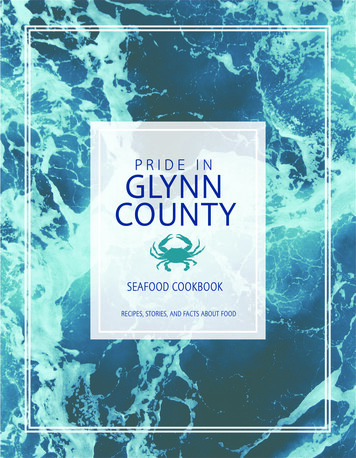
Transcription
PRIDE INGLYNNCOUNTYSEAFOOD COOKBOOKRECIPES, STORIES, AND FACTS ABOUT FOOD
PRIDE INGLYNNCOUNTYSEAFOOD COOKBOOKRECIPES, STORIES, AND FACTS ABOUT FOOD
ACKNOWLEDGMENTSWe thank the many fishers, crabbers, shrimpers and consumersof seafood who have lived in and around Glynn County overhundreds of years, and who have celebrated our rich anddiverse culture, especially our food!INTRODUCTIONPeople who live around Brunswick love nothing better than a goodseafood dish, and they also love to talk about a great seafooddish! We are blessed to live near a saltwater marsh that is hometo a bountiful fish population. The marsh and fishing have beenpart of our community’s long history and are celebrated today bylocal chefs, festivals, family get-togethers and church fish dinners.We thank all of our neighbors who contributed their art andtaste for this first “Pride in Glynn County” cookbook. We thankHoneywell for its financial support. We thank our co-workersfrom the Environmental Justice Advisory Board, RebuildingTogether – Brunswick and the University of Georgia MarineExtension and Georgia Sea Grant who supported us andprovided endless feedback on how to create a resource thatcelebrates who we are as Southerners, and how we can eat sus tainably from our marshes.We asked some of our favorite local cooks to share their recipesand stories. Some cook for a living; others for the pure joy of it.This book is dedicated to those who will continue to honor andcarry on these traditions.EAT SEAFOOD, EAT LOCALAnd, importantly, this book is dedicated to YOU! Enjoy andstart cooking!Created by: Members of the Glynn County CommunityCompiled by: Kimberly Andrews, Doris Dollar Carter (2019)Cover and Layout Design by: Brandon DudleyWe invite you to explore the recipes found in our first “Pride inGlynn County Seafood Cookbook” and try new ways to enjoyfresh local fish. The University of Georgia Marine Extension andGeorgia Sea Grant offers tips for safe and healthy ways toprepare the catch of the day. To follow the guidelines preparedby the Georgia Department of Natural Resources for enjoying ahealthy seafood dinner: know which species can be eatenfrequently, and which should be dinner less often or not at all.Because Brunswick has a strong industrial past, manufacturingactivities have impacted the marsh environment. For the past twodecades the U.S. Environmental Protection Agency (EPA) and the statehave been addressing those impacts. Thanks to these efforts andmonitoring of seafood, we know how to enjoy a healthy seafood diet.Guidelines to consumption of seafood from the area are found at: s
PRIDEGLYNN COSEPEMEET THE LOCALSGLYNN COGLYNN COAFDOOUNTYOOMany fish found in our marsh are popular with anglersand many of us who love a good seafood meal. What’syour favorite seafood?ShrimpSpotBlack DrumRed Drum (Redfish)Blue CrabStriped MulletSpotted SeatroutFlounderAtlantic CroakerData provided by the US Fish & Wildlife Service National Wetland InventoryWhitingSheepsheadFinfish illustrations Diane Rome PeeblesUNTYTidal salt marshes are located on theeast coast of the U.S. between barrierAFislands and the mainland. Their waterO ODis a mixture of salt and fresh water. Werefer to this as “brackish.” Glynn County supportsmany types of wildlife and aquatic life, including RIDP Epopular seafood items like the fish, crabs and shrimp.SESEThe fish that call it home are a great source of seafood.GLYfishingHealthy fish populations provide recreationalNN COfromUNland or boat. They keep the local economy rolling by T YAFsupporting commercial fishermen, stores and restaurants.PRIDESEUNTYGeorgia’s saltwater marshes boastbountiful populations of fish. A mixtureAFof salt and fresh water, the marsh isO ODfound between the mainland and the openocean. It provides beautiful scenery and attractswildlife year-round.RIDOUR MARSH AND FISHERIESDFISH, WILDLIFE AND PLANTSSalt Marsh Tidal Creeks and OceanSalt Marsh Flats (grassy)Freshwater Habitats
DORIS DOLLAR-CARTER'SSHRIMP CREOLEI live in Brunswick and I am theMadame Chairman of theEnvironmental Justice AdvisoryBoard. I am also a retired catererand am passionate about feedinggood, wholesome food to my friendsand loved ones! This recipe was onemy mother’s, Phoebe Dollar’s,favorites - she made it for years, forfamily dinners and dinner guests orchurch socials. Now I have made itfor years for my people and amsharing it here with you.A coastal living is a way of life formany. I remember my grandmotherwould go fishing in the creeks ofGeorgia. She would catch brims. Idid fish in my youth and as a youngadult, but not anymore. Myex-husband to this day is still afisherman, not as a profession, butfor him, it’s a lifestyle.INGREDIENTS¼ cup coconut oil1 large onion, minced¼ teaspoon paprika1 medium green pepper, minced3 ½ cups fresh or canned tomatoes1 clove garlic, minced1 pound large shrimp, cleaned & cooked2 Old Bay leaves3 cups hot cooked rice or noodles½ teaspoon saltpepper to tasteDIRECTIONS Melt coconut oil on low heat, in a saucepan. Add the onion, green pepper, garlic, and OldBay leaves and sauté 10 minutes, or until tender. Add the salt, a dash of pepper, paprika,tomatoes and bring to a boil. Reduce the heat and simmer 15 minutes. Add the shrimp and heat thoroughly. Serve over hot cooked rice or oriental noodles.Almost 30% of Glynn County is water —freshwater, marsh, and ocean.CHRISTOPHER MAHONEY'SSHRIMP IN SPRINGGrowing up, my parents, originally from Philadelphia, were not interested in freshshrimp. Living on the coast, of course, I became friends with a family or two thathad a shrimper as the head of the household. I learned to cook shrimp occasion ally on my own, always listening to the advice of my friends and neighbors. Iprepare many versions of this recipe, usually once to twice a month, depending onprice and availability of shrimp. I know it may be blasphemy in these parts, but Inever much enjoyed fishing like so many of my neighbors do. My son and I prefercrabbing, both the experience and the results! We can swim and crab on Jekyllsimultaneously. I have learned my lesson about tethering the net loosely to myswimming shorts though! Some of those crabs are wilier than I thought!INGREDIENTS1 lb. medium or large fresh Georgiashrimp (peeled and deveined) cutinto bite-sized pieces1 ½ lbs. red potatoes(chopped large pieces)1 large zucchini (chopped)1 large yellow squash (chopped)½ large red onion (diced)2 cloves of garlic (minced)1 tablespoon basil (fresh)1 tablespoon paprika1 tablespoon garlic powderSalt and pepper3 tablespoons olive oilDIRECTIONS Coat a medium-size frying pan with olive oil. Sauté chopped red potatoes on medium heat until lightlybrowned, turning regularly. In a separate medium sauce pan, place chopped shrimpin ½ inch of water, add dash of salt and garlic powder,cover and cook. Stir occasionally, until shrimp begins to turn pink. Drain,set aside. When potatoes are yellowy brown, add ½ ofdiced onions and two cloves of garlic. Stir for 1-2 minutes, until onions are slightly tender, addthe zucchini and squash and cook for 4-5 minutes. Addother ½ of onions and the shrimp. Once shrimp begin to darken cook 2 more minutes, addpaprika and basil. Stir well. Add salt and pepper to taste.
HERBERT (TRUCK) McIVER'S2 SHRIMP DISHESwith OKRA and GRITSI have always eaten or made this dish. I ate it coming up and now fix it onthe R/V Georgia Bulldawg (UGA research vessel) because I work for UGA MarineExtension and Georgia Sea Grant and spend time out on the water. Either ofthese recipes can be prepared easily and on a boat. I’m from McIntosh County. Iused to go out fishing with my dad and had some good times. The water waseverything to us. My father was a shrimper and all his brothers were shrimpers.I started at about 8 or 9 years old. Got older, I became a teenager and everysummer that was my job. I had to learn [shrimping] the hard way. I wasdrafted into the military and came right back to it after that. Raised kids doingit, it was a struggle though. Time done past, don’t dwell in it. There used to be900 shrimping licenses in the state, now there are only about 200. Now the localfishers have a hard time not being outcompeted by imports. I still enjoy fishingand can do it without the stress.Georgia’s salt marshes are nature’snurseries. They create a place for fish toeat and protect young fish frompredators.SHRIMP AND OKRAINGREDIENTS3 strips breakfast bacon, cut into 1” piecesOnion, sliced thin½ bell pepper, sliced thinShrimp, whatever you have, totally cleanedSalt and pepperOkra, fresh or frozen, cut up1 teaspoon vinegarLemon juiceCrushed red pepper1 tablespoon butterRice (whatever you like)SHRIMP AND GRITSINGREDIENTSShrimp, cleaned (peeled, deveined ifdesired)Four strips bacon, cut into piecesFlourBell pepper, diced or choppedOnion, diced or choppedGrits or riceDIRECTIONS Use a thick skillet that is heavy so things won’t burn asquick. Stir fry the bacon in pan by itself, keep drippings. Make itclose to done but not crispy. Sauté the onion slices in drippings. Sauté the bell pepperbriefly. Turn heat down on skillet. Heat water on the side until it is close to boiling. Add shrimp to pepper and onion mix in the skillet, turnover until shrimp change color. Add about 1 cup of water to mix and add bacon back tomix. Let it come to a boil. It should be jumping a little bit. You can use fresh or frozen okra; the fresh is really good.Add okra until shrimp are jumping. Let okra set until it’sjumping a bit. Add a teaspoon of vinegar to cut slime off okra. Addcrushed red pepper and a little bit of lemon juice. Salt and pepper to taste. Accent for flavor. Make surepan isn’t too hot or okra will stick. Add butter.DIRECTIONS Start water to boil in a large pot on the side. Dice four strips of bacon and toss in a skillet. Remove bacon when it is partially cooked (still pink andslightly raw). Dress shrimp with flour then add to skillet. Roll arounduntil get a little color, just enough to brown. Remove some of grease. Sauté bell pepper and onion, then add partially cookedshrimp and bacon. Add a little bit of the boiling water, not even enough tocover. Flour on the shrimp will make the gravy thick andadds color. Add water as needed. Put top on, let it go for 15 minutes or more, check shrimp. Add grits or rice or whatever you want. Quantities easily adjusted to number of people eating.
JOVAN SAGE'SFARM-STYLE PICKLED SHRIMPI had been visiting the Golden Isles for two years before I decided to make the fullmove to Brunswick, Georgia. Part of falling in love with this coast has centeredaround the bounty from our coastal waters and local farms (including ours). Iquickly fell in love with Georgia wild caught shrimp. As a food alchemist who lovesto pickle, I wanted to incorporate the seasonality of shrimp, pickling spices, freshgarlic and onions from our farm into a fun finger food. Now, after five years ofcalling Brunswick home, this recipe morphs with the season and has become one ofmy staples. I’ve even incorporated it into my Quick Pickling class where students aredelighted to find how easy and tasty this dish can be.INGREDIENTS1 red onion, thinly sliced1 lemon, thinly sliced3/4 cup apple cider vinegar1/2 cup olive oil3/4 teaspoon celery seeds1/2 teaspoon sugar1/2 teaspoon salt1/4 teaspoon black peppercorns1/4 teaspoon chili flakes (or more to taste)1 bay leafHandful of garlic cloves1 1/2 pounds peeled and deveined shrimpDIRECTIONS Bring large pot of salted water to boil. Toss in shrimpand cook for 3 minutes. Drain and set aside. In a large pot, combine apple cider vinegar, salt, celeryseeds, black peppercorns, sugar, chili flakes. Bring to a low boil. In a large glass jar or bowl combine the olive oil, bayleaf, red onions, lemon, garlic and cooked shrimp. Addthe brine and toss to combine. Cover and refrigerate for a minimum of 24 hours,stirring occasionally. Serve chilled. Keeps for at least aweek.1/3 of the salt marshes on the East Coastof the U.S. are located in Georgia.MARTY HIGGINS'SHRIMP AND CONCHI am retired from the UGA Marine Extension and Georgia Sea Grant after spendingmany years on the water as a commercial fisherman. I learned to cook from myfamily – my Daddy’s mom was real good at cooking seafood and her mom wastoo. I prepared these meals every now and then – mostly when we were on the boatto cook things that we were catching on purpose, like shrimp, and things we weretrying not to catch, like the conchs. Sometimes we would get a load of conchs; whenthey cover the ground the nets pick them up. It’s just a way of life.It’s hard work sometimes, most of the time. Money was there if you worked but ithas dwindled down. Now it is hard to make it on this river. I hope it comes back butwhere are you going to tie up? We have lost marinas and supply houses.Manufacturers who supply and deliver parts are going out of business. Thereused to be fleets of boats, now there are a few. My stepboys don’t fish – they gotgood-paying jobs. I still try to go fishing and get on the water when I can.INGREDIENTSshrimpconchs (whelks)salt and peppergarlicDIRECTIONS Cook shrimp with the head on so the shell detaches easily and more flavoris retained. Boil in a pot of water until the shrimp are about halfway done(change color) then remove from heat. As soon as shrimp start to float, dump right away. While still steaming, put shrimp in cooler and separate with newspaper tokeep them from getting tough. Select a conch that you can fit in your hand, but big enough that your handwon’t fully close: the big ones are tough. Wash thoroughly. Boil an appropriately sized pot of water for 10-15 minutes, until it reaches arolling boil. Add plenty of salt and pepper, garlic; you can make hot/spicy if you like. The conch will come out of the shells; hard foot will fall off. Eat foot straight like boiled shrimp. Can also slice like a marshmallow or runthrough a sausage grinder to make a patty. Quantities easily adjusted to number of people eating.
JULIE HUNTER MARTIN'SSMOKED OYSTER SPREADand CRAB DIPI moved to Glynn County in 1995 from Atlanta and have lived in the city ofBrunswick since 2000. Because I was allergic to seafood growing up and incollege years, I’ve been reluctant to eat much seafood other than shrimp, craband fresh fish. My recipes for crab dip and smoked oyster spread were passedon to me by my mother and her dear friends. I love preparing them asappetizers. While I’m not “gaga” over seafood due to my early-life allergy, ILOVE living on this coast and enjoyed watching my two daughters grow up hereand being influenced by not only the wonderful people, but the fabric of life inthe intracoastal waterway and its role in our ecosystem. I adore the smell of themarsh, the sound of the shore birds, witnessing the annual migration of birds,the loggerheads and even the wrack and detritus that mark the high tide eachday.CRAB DIPINGREDIENTS1 cup crabmeat (fresh, canned orfrozen)3 tablespoons lime or lemon juice3 oz. cream cheese, softened¼ cup cream2 tablespoons mayonnaise2 teaspoons grated onion or mincedgreen onion2 dashes TabascoTwice a day, waterrushes in and out ofthe marsh. Georgia hassome of the highest tideson the east coast of theU.S., averaging 6-9 feet.DIRECTIONS Marinate crab in juice for 30 minutes. Beat all other ingredients together until smooth. Drain crab, reserving its juice, and stir it into the cream cheese mixture. Taste and addsome of the juice if needed. In zucchini cups: Chill crabmeat. Drain if still too juicy. Select8 small zucchini squashes, each about 1 ½” X 6”. Cut six ¾” slices from each. With a melonball cutter, hollow the center of each slice and fill it with crabmeat. This should make 4dozen cups or more. Perfect with crudites or chips, or serve in artichokes or in zucchini cups.SMOKED OYSTER SPREADSeafood is a good source of protein andhealthy omega-3 fatty acids. These areimportant “good fats” that the humanbody does not produce.INGREDIENTS1 can (3 ¾ oz) smoked oysters, drained8 oz. cream cheese, at room temperature1 green onion, minced (include green top)1 tablespoon mayonnaise2 teaspoons fresh lemon juice1 teaspoon Worcestershire saucePinch of garlic saltDIRECTIONSCut up the oysters and mash them with a fork. Combine with all other ingredients andpack into a 2-cup mold or small bowl. Refrigerate for several hours. Unmold onto a plategarnished with fresh parsley. Serve with crackers.
JEFF AND ANGELA CLARK'SPORT CITY LOW-COUNTRY BOILHi, I’m Jeff Clark and I live and work in Brunswick. As Street Outreach Directorfor Safe Harbor Children’s Center, a home for children who need a safe, lovingenvironment, I’m always on the move. My special low country boil can beprepared to restore my family’s energy after a busy week or to bring friendsand family together in celebration. My recipe is marked by how I mix myspices, and what kinds of fresh seafood I add. And it’s adaptable dependingon the season of the year or how many people you are having over.I developed the recipe myself, over time, through trial and error. I hopeeveryone will try it and enjoy!DIRECTIONS Low-country boil is easy because you boil water in abig pot and toss in your ingredients! The flavors combineinto a delicious medley. Chop all meat and vegetables into bite-sized piecesexcept for the crab and shrimp. Red potatoes can be leftwhole if you prefer. Bring water to boil. Add neck bones, corn on the cob,potatoes if left whole, citrus (lemons and oranges), OldBay, Zatarains, cayenne, and eggs (with shells). Ratiosabove are merely suggestions, season to your taste! Boilfor approximately 10 minutes (until potatoes are abouthalfway done). Add celery, onions, sausages, and blue crab. Boil foranother 5 minutes or so and add shrimp. Cooking timewill vary depending on the size of your bites and yourpreference. Test potatoes with a fork, and cook meatuntil no longer pink. Give it a taste test to tell when it isready! Serves 15-20, depending on the appetite of your crewand your desire for leftovers!INGREDIENTS6 dozen blue crab (claws)4 pounds fresh jumbo shrimp3 pounds smoked sausages2 pounds smoked pork neck bones1 bag of red potatoes1 bag of corn on the cob1 stalk of celery2 white onions chopped3 sliced lemons2 sliced oranges1 cup of Old Bay Seasoning1 cup of Zatarains crab boil3 dashes of cayenne pepper2 dozen white eggsCHEF MATTHEW RAIFORD'SGEORGIA COAST PAELLAI remember as a child growing up on the Georgia Coast and always beingfascinated with the abundance of seafood that was available that we ate allthe time: Oyster roasts on hot tin, my Nana Ophelia and my Mom making apot of Shrimp Creole, my great grandmother Florine frying whitings on Fish FryFridays, and driving by local churches to grab a fish sandwich with white breadand hot mustard. I think that’s why I have always loved the process of makingpaella. It has always reminded me of home. Paella is also a dish that has all ofthe attributes of the Georgia Coast in one dish: Spanish influence, rice, and anabundance of seafood! The process of making paella also reminds me of whatmy Nana would always say about cooking “you can’t rush the goodness baby!”INGREDIENTS2 tablespoons olive oil3 cloves garlic, minced1 teaspoon crushed red pepper flakes2 cups uncooked Carolina Gold Rice1 pinch saffron threads1 bay leaf1/2 bunch Italian flat leaf parsley, chopped1 quart seafood stock2 lemons, zested2 tablespoons olive oil1 Spanish onion, chopped1 red bell pepper, coarsely chopped1 pound smoked sausage30 Sapelo Island Clams1 pound large Georgia wild caught shrimp,peeled and deveined2 lemons, quarteredDIRECTIONS Heat 2 tablespoons olive oil in a large skillet or paellapan over medium heat. Stir in garlic, red pepper flakes,and rice. Cook, stirring, to coat rice with oil, about 3 minutes. Stir in saffron threads, bay leaf, parsley, seafood stock,and lemon zest. Bring to a boil, cover, and reduce heat tomedium low. Simmer 20 minutes. Do not stir. Meanwhile, heat2 tablespoons olive oil in a separate skillet over mediumheat. Stir in onion; cook 5 minutes. Add bell pepper and sausage; cook 5 minutes. Addsausage mixture to rice. Push clams into paella; as soon as first clams pop openadd shrimp in a circular pattern. Once shrimp turn bright orange, remove paella fromstove and add lemons.
CHEF DAVE SNYDER'SSAUTÉED SPECKLED TROUTwith CRAB SCAMPI BUTTER SAUCEWater, of course, is a HUGE part of our culture from the economic impact tothe living environment. So many of our jobs depend both directly andindirectly from the ocean and rivers. Tourism, of course, depends greatly onthe marine environment. For me, the water means a lifestyle I never knewuntil I moved here. For work, the ocean provides me a livelihood. For mymind, it provides me entertainment, solitude, adventure, and I hope anever-ending classroom. I try to fish one hundred days a year. Once in awhile, I’ll harvest fish to serve in the restaurants or at home with friends.Memories are countless and I try to add new ones every week. My bestmemory seems to change the more I’m on the water. The recipe was createdin Halyards as a menu item. We run it as a special occasionally since it wason the menu a few years ago. It’s special in that the primary ingredients canbe caught every day within a few miles of therestaurants.INGREDIENTSFish2 Georgia trout fillet, no skin2 oz Georgia Olive Farms olive oilsalt and pepperSauce2 tablespoons shallots, peeled and minced1 teaspoon garlic, peeled and minced4 oz. white wine1 tablespoon lump crab meat4 oz. unsalted stick of butter, cold1 tablespoon tomato, chopped1 tablespoon parsley, chopped½ lemon to juicesalt and pepper as neededDIRECTIONS Lightly season one side of fish with salt andpepper In hot pan, add oil then fish. Cook until brown. Flip and finish. Should take total of about 3minutes depending on thickness. When you remove the trout from the pan aftercooking, add shallots, garlic and wine. Reduce by 80%. Add crab and slowly whisk in butter. Add tomato, parsley and lemon juice. Season with salt and pepper.KIMBERLY ANDREWS’FAMILY FISH MATECUMBETo me, living around the water is defin ing. It is how I start and end my day. Asan ecologist, I have dedicated my careerand a personal love to these habitats.Eating seafood is not only delicious, but itis a celebration of being a coastalSoutherner, it is a tiding to one of themany ways in which we are fortunate tobe living here. I eat seafood because itis healthy in addition to being delicious,and it brings me back to my favoritememories of growing up preparing localcoastal dinners with my family.My mother passed on her passion forcooking to me and my brother, who nowis a chef. Both sides of my family comefrom farmers, so we know how to cookwell and affordably. This recipe isadapted from my mother who preparedit for me – it is fast, easy, nutritious andcan be adapted to the fish and vegetablesof your choice.INGREDIENTS½ onion, chopped1 8 oz. jar capers (can substitute olives)5 shallots, peeled & chopped5 tomatoes, chopped¼ cup chopped basil leaves½ tablespoon salt½ tablespoon ground black pepper2 lemons, juiced1 cup olive oil8 individual fish fillets of your choiceDIRECTIONS Combine all ingredients except fish.Refrigerate until ready to use, at least 1 hr. Place oven rack at least 4” from broiler but nomore than 6”. Place fillets on baking sheet with lip& season with salt and pepper. Broil on low untildone on one side. Turn over and top with sauce.Broil until fish is done. Side dish suggestion – Rice, but anything goeswell with this dish and any fish works.Marshes protect coastal communitiesfrom flooding and storms.
PRIDEGLYNN COSEGEORGIA SEAFOODCONSUMPTIONGUIDELINESAFWomen who are pregnant or nursing andchildren under the age of seven are mostUNTYvulnerable to environmental contaminantsO ODbecause they experience higher rates ofgrowth and development. The state guidelinestake a conservative approach based on whatPeople can enjoy a healthy local seafood diet by being aware of potentialis considered safe for pregnant women andhealth risks and by managing their daily dietary practices. The GeorgiaPRIDEchildren. Remember risks of exposure toDepartment of Natural Resources (DNR) produces annual recommendationsGLYNNspeciesCOUhavestate can be eaten safely. Depending on the zone, someNTnoYrestrictions, while others should only be eaten once a month or once a week,on how often certain seafood from designated fishing zones around theAFOODSEwhile others should be avoided altogether.environmental contaminants will vary greatlyfrom person to person! Just as these contaminants can accumulate over timein fish, they can be stored in people who eat these fish that eat smaller fish ororganisms living off the sediments.Please check the following DNR consumption guidelines when fishing in theseareas in Glynn County. When you fish in other Georgia waters, follow DNRguidelines found online: sFOUR CORE FOOD SAFETY PRACTICES FOR PREPARATION:CLEANSEPARATECOOKCHILLTURTLE RIVER ESTUARYLower Turtle & South Brunswick Rivers (St. Simons Estuary)SPECIESAccording to the DNR, people can maintain a healthy fish diet and reducetheir risk of exposure to heavy metal (mercury) and poly-chlorinated biphenyls(PCB) by 25-50% if they: eat smaller, younger fish that have accumulatedlower levels of contaminants; eat a variety of fish species; eat different kindsBlack Drum, Blue Crab, Red Drum,Shrimp, Southern FlounderClams, Mussels, Oysters(species) of fish for a varied diet; eat smaller portions of big fish; clean andcook fish properly; remove the skin and the guts; clean off fatty areas (belly,side, back); and cook fish so the fat drips away (broil, bake, or grill).For crab, remove the tomalley (also called mustard, green/brown stuff, greengland) of crabs before eating. This is where contaminants concentrate.AREA SAMPLEDAtlantic Croaker, Spot, StripedMullet Sheepshead, SouthernKingfish (whiting), Spotted Seatrout1 meal/weekNo RestrictionsShellfish Ban*Middle Turtle River (St. Simons Estuary)SPECIESAREA SAMPLEDAtlantic Croaker, Spot, StripedMullet, Southern Kingfish (whiting)(Do not reuse the cooking liquid for sauces, soups, or stews. Roughly 80Black Drum, Sheepshead BlueCrab, Red Drum, Spotted Seatrout,Shrimp, Southern Flounderpercent of the PCBs found in crabs move into the cooking liquid duringClams, Mussels, Oysterssteaming/boiling.)Turtle River(from Marker9) and SouthBrunswick River(downstream toDubignon andParsons)RECOMMENDATIONRECOMMENDATION1 meal/monthState Hwy 303 toChannel Marker 91 meal/weekShellfish Ban*
ndherablentsherment.orposurepersone overfishents.heninnline:ENDATIONPurvis & Gibson Creeks (St. Simons Estuary)SPECIESSpot, Spotted SeatroutRed Drum, Black Drum, SouthernFlounder, Blue Crab, SheepsheadShrimph Ban*RECOMMENDATIONDo Not EatPurvisandGibsonCreeksClams, Mussels, Oysters1 meal/month1 meal/weekNo RestrictionsShellfish Ban*Upper Turtle & Buffalo Rivers (St. Simons Estuary)SPECIESAtlantic Croaker, Spot, Striped MulletBlack Drum, Sheepshead, SouthernKingfish (whiting), Blue Crab, RedDrum, Spotted SeatroutShrimp, Southern FlounderAREA SAMPLEDRECOMMENDATION1 meal/monthTurtle and BuffaloRivers, Upriver ofGeorgia Hwy 3031 meal/weekClams, Mussels, OystersNo RestrictionsShellfish Ban*TERRY & DUPREE CREEKS & BACK RIVERTerry Creek - SouthSPECIESSilver Perch (Yellowtail)AREA SAMPLEDBlue Crab, Shrimp, Spot, StripedMullet, Atlantic Croaker, SouthernKingfish (whiting), Spotted SeatroutClams, Mussels, OystersTerry CreekSouth of TorrasCauseway toLanier BasinRECOMMENDATION1 meal/weekNo RestrictionsShellfish Ban*Terry & Dupree Creeks - North/weektrictionsAREA SAMPLEDAtlantic Croaker, Southern Kingfish(whiting), Striped MulletSPECIESAREA SAMPLEDStriped MulletSouthern Kingfish (whiting), Spot,Atlantic CroakerBlue Crab, Shrimp, Red Drum,Spotted SeatroutTerry & DupreeCreeks North ofTorras Causewayto Confluence withBack RiverClams, Mussels, OystersENDATIONRECOMMENDATION1 meal/month1 meal/weekNo RestrictionsShellfish Ban*Back River - North/monthSPECIESAtlantic Croaker/weektrictionsBlue Crab, Shrimp, Striped Mullet,Southern Kingfish (whiting), SpottedSeatrout, Red Drum, Spoth Ban*Clams, Mussels, OystersAREA SAMPLEDBack River 1 mileabove Terry Creekto Confluence w/Torras CausewayRECOMMENDATION1 meal/weekNo RestrictionsShellfish Ban*Back River - SouthSPECIESBlue Crab, Shrimp, Spot, StripedMullet, Southern Kingfish (whiting),Spotted Seatrout, Red Drum,Atlantic CroakerClams, Mussels, OystersAREA SAMPLEDBack River fromTorras Causewayto St. SimonsSoundRECOMMENDATIONNo RestrictionsShellfish Ban**Shellfish Ban: National Shellfish Sanitation Program. For information see Coastal Resources Division website: https://coastalgadnr.org
iMarine Extension andGeorgia Sea Grant UNIVERSITY OF GEORGIAISea h'-' Jl- ·.Together.
Add the salt, a dash of pepper, paprika, tomatoes and bring to a boil. Reduce the heat and simmer 15 minutes. Add the shrimp and heat thoroughly. Serve over hot cooked rice or oriental noodles. DORIS DOLLAR-CARTER'S . SHRIMP CREOLE . INGREDIENTS DIRECTIONS . Almost 30% of Glynn County is water — freshwater, marsh, and ocean.
